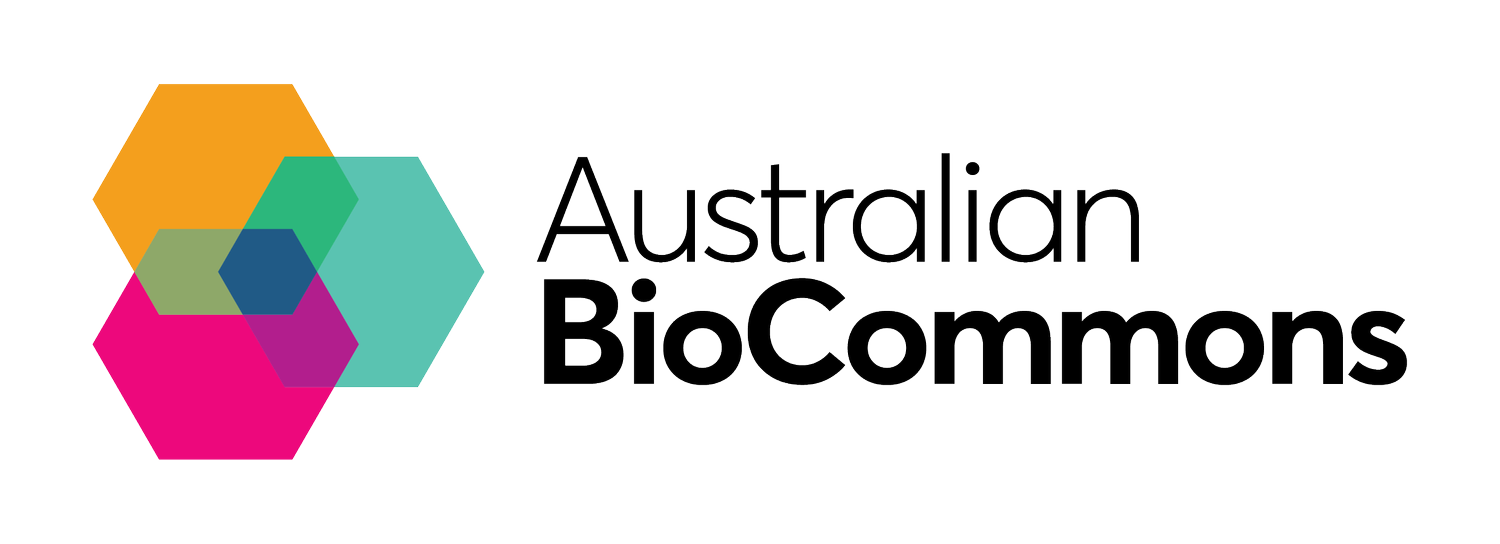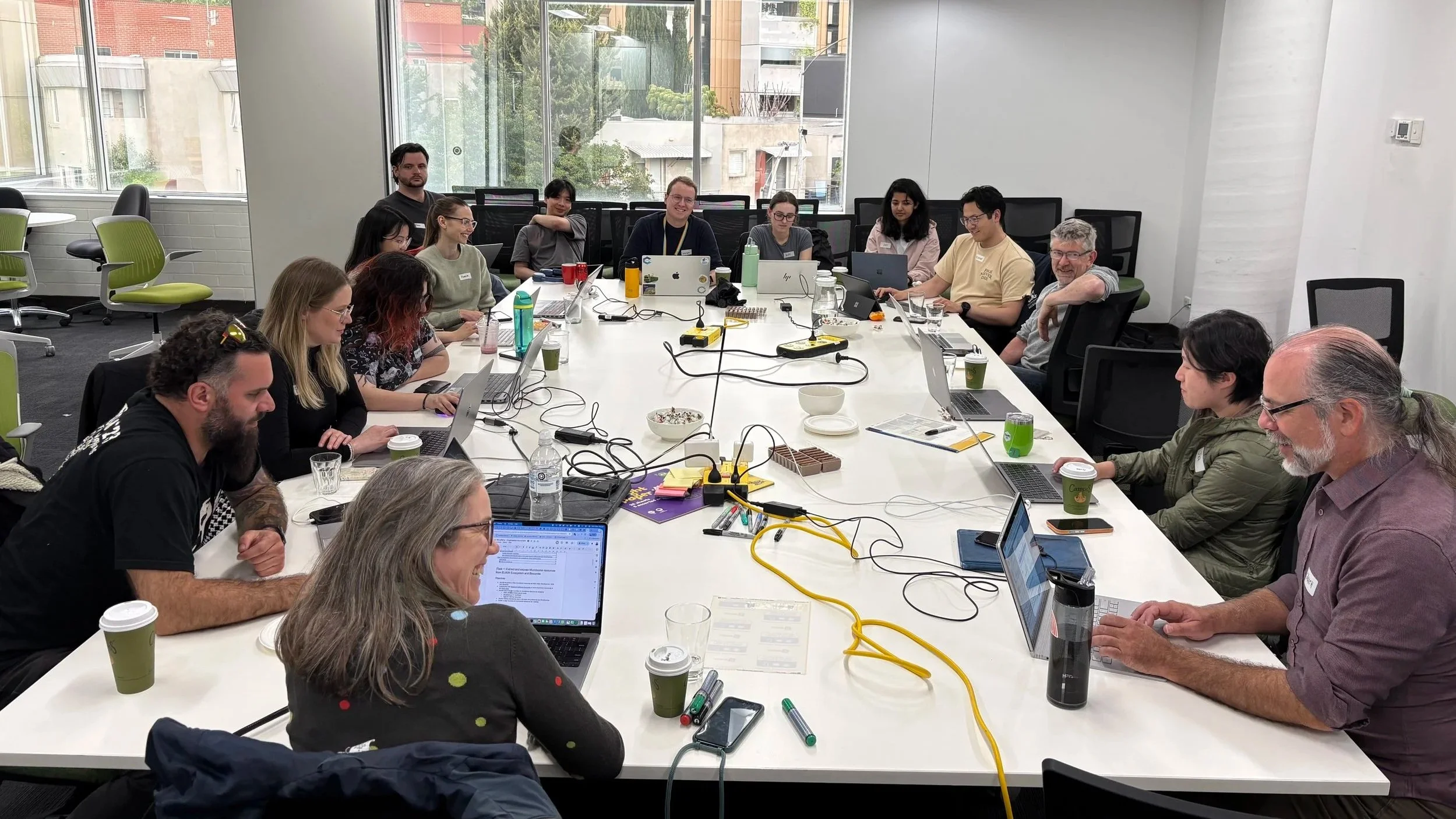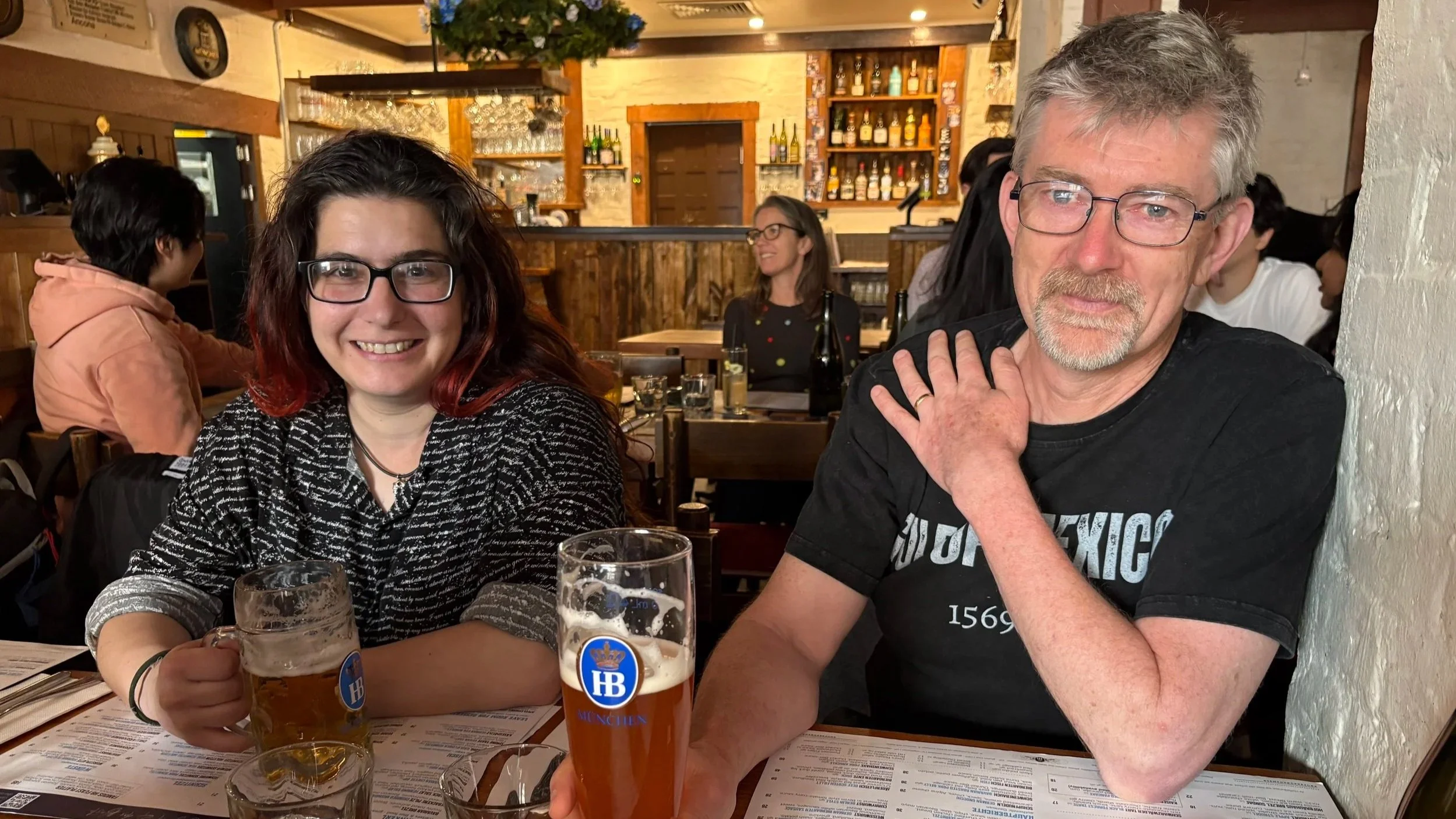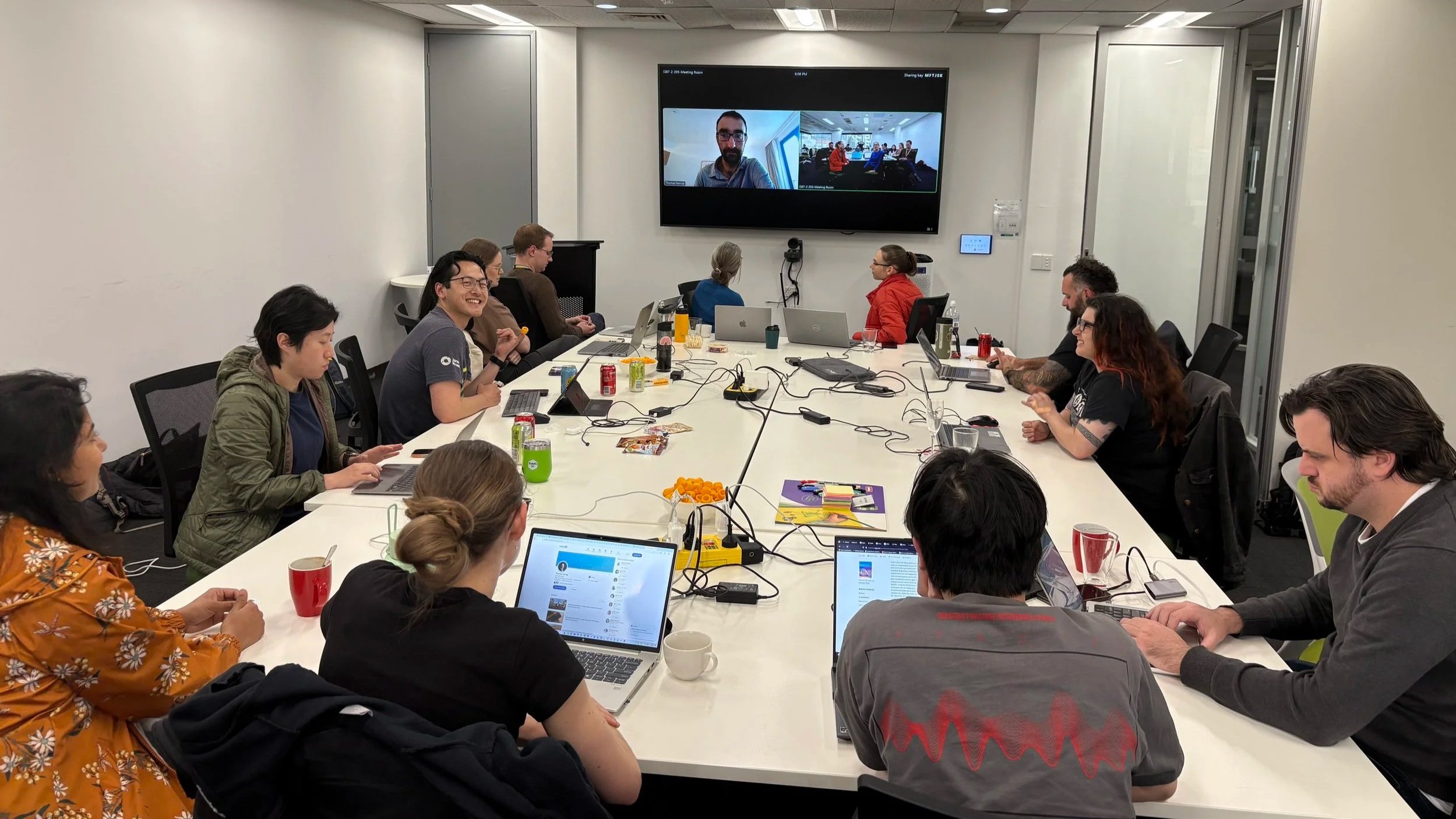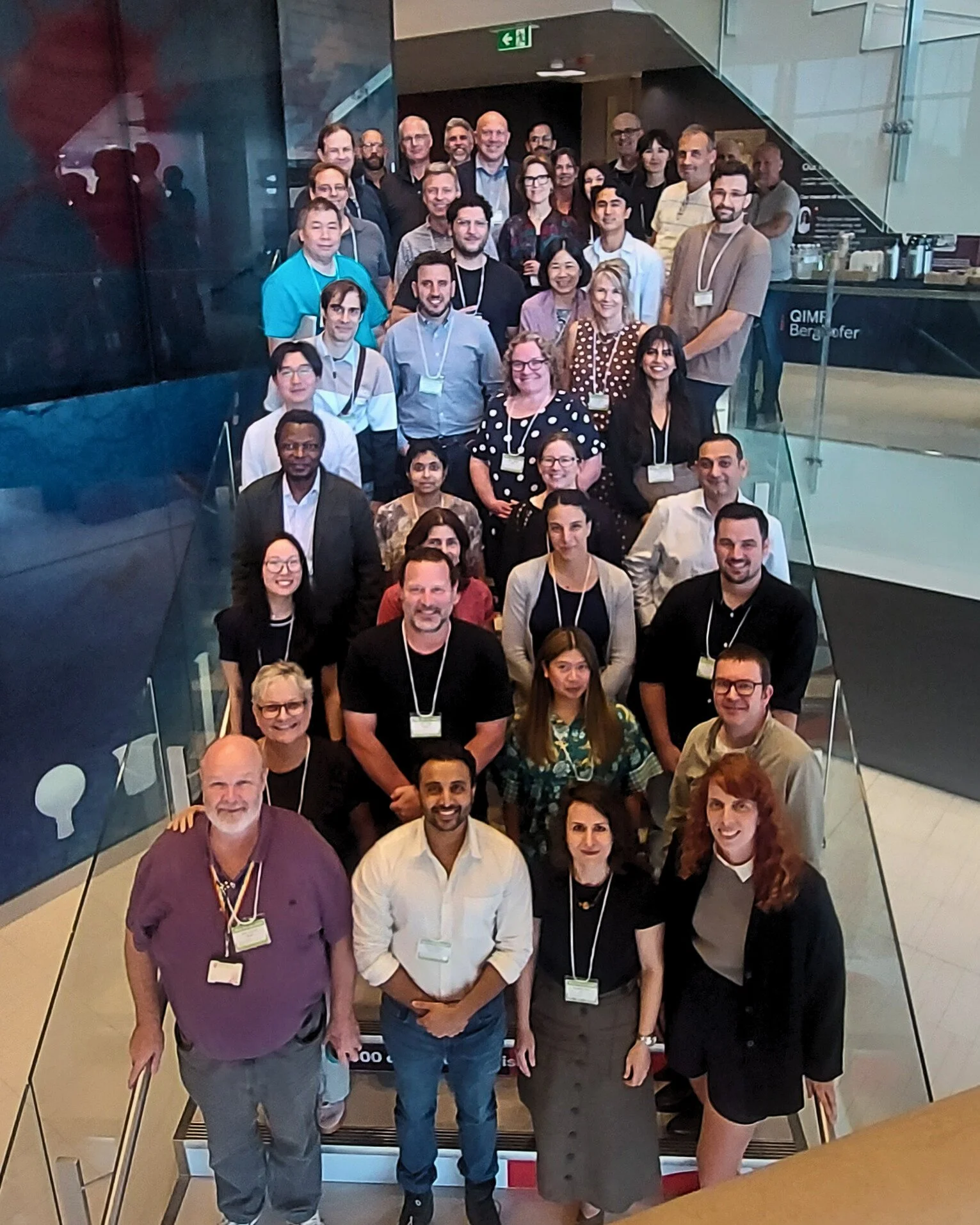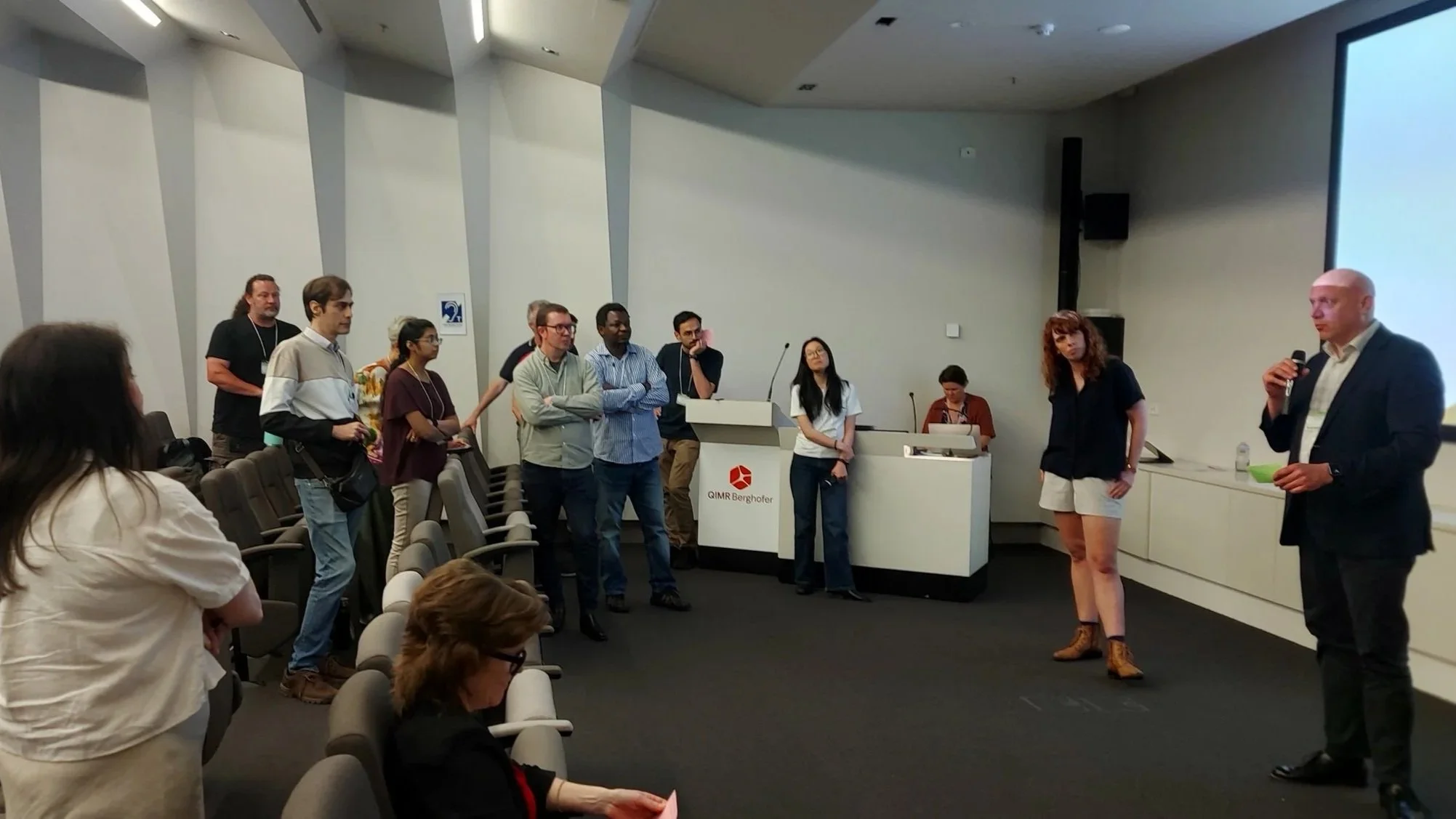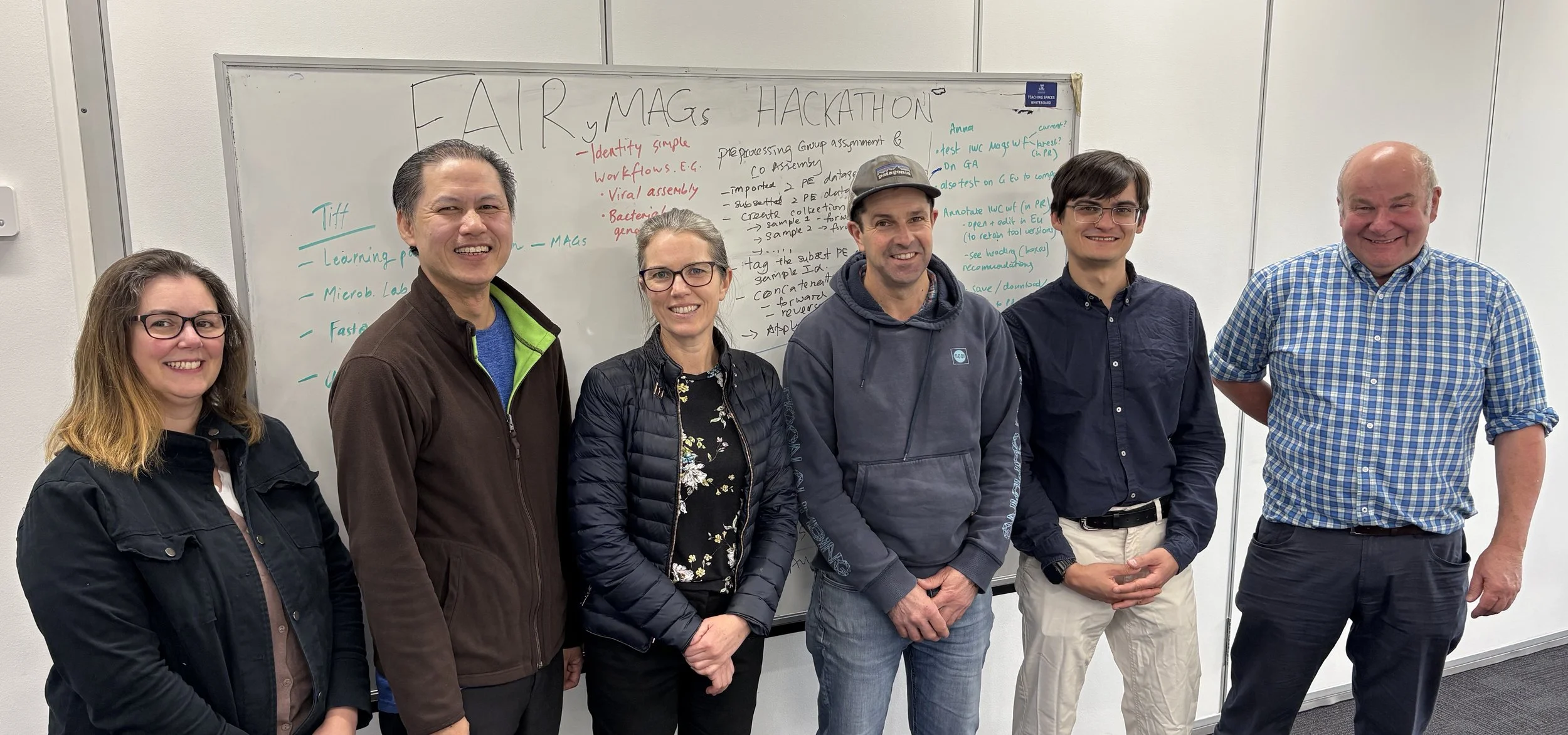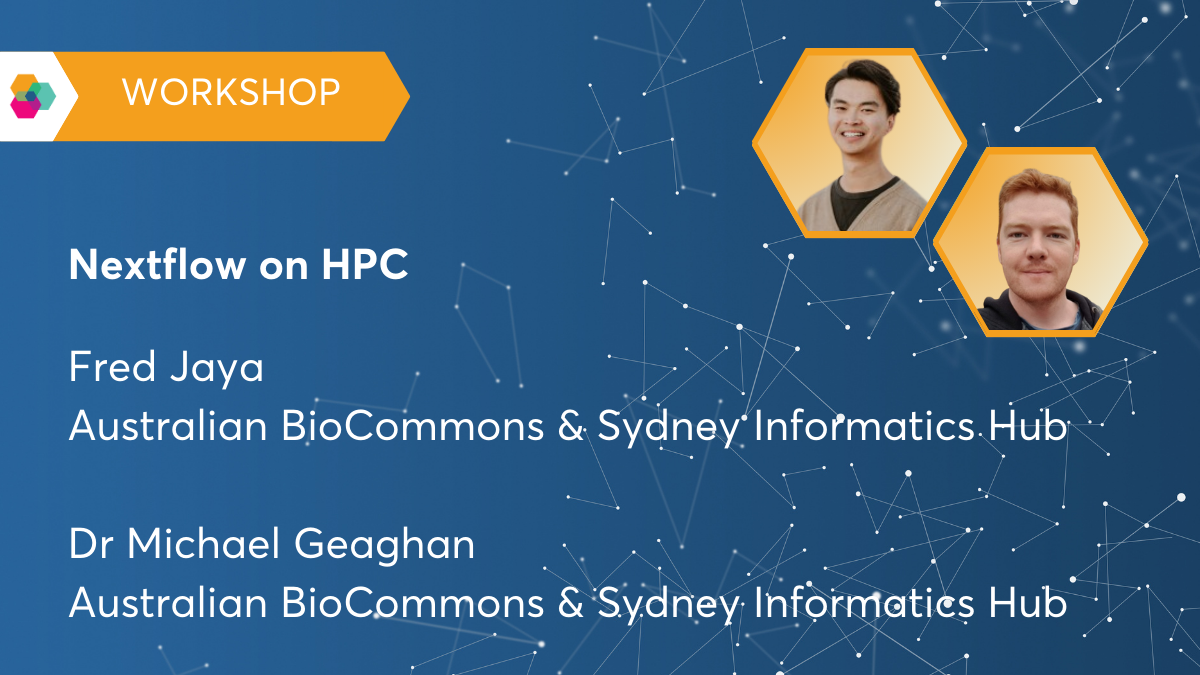News
Subscribe to the Australian BioCommons monthly newsletter or read previous editions
Solving the big international bioinformatics challenges from the comfort of home
The Australian Outpost of ELIXIR’s BioHackathon Europe, running for the fourth consecutive year, recently brought together 16 bioinformaticians from across Australia to the University of Melbourne for an intensive week of collaborative coding.
The Australian Outpost of ELIXIR’s BioHackathon Europe, running for the fourth consecutive year, recently brought together 16 bioinformaticians from across Australia to the University of Melbourne for an intensive week of collaborative coding.
Facilitated by BioCommons’ ongoing partnership with ELIXIR, the event provided a unique opportunity for local experts to contribute directly to global bioinformatics projects, connecting with their local peers and linking into the main BioHackathon Hub in Berlin.
From 3-7 November, the Australian team worked from 12:00 - 8:30 PM AEDT each day to ensure overlap with their European counterparts. This year’s outpost dedicated its efforts to three key projects.
Team members collaborating during the BioHackathon
One team tackled the challenge of using BUSCO (Benchmarking Universal Single-Copy Orthologs) tools for phylogenomics. BUSCO genes are standard for assessing genome assembly and annotation completeness, but their use in phylogenetics is often challenged by gene duplication (paralogy). Representatives from BioCommons, University of Melbourne, University of Sydney, Curtin University, and University of Tasmania collaborated with peers around the world to build an automatic pipeline that explicitly resolves these paralogy events, which will result in larger, more informative datasets for biodiversity research.
Another team brought together experts from BioCommons, Curtin University, University of Melbourne, QIMR Berghofer, and University of Queensland to focus on expanding the benchmarking landscape for long-read transcriptomics. While foundational benchmarks for long-read RNA-Seq were established in 2020, the field has evolved rapidly since then with new tools and protocols. This project worked towards an updated benchmark, leveraging new datasets to ensure the reproducibility and comparability of modern transcriptomics research.
The final project brought together a ‘supergroup’ from the Australian Tree of Life (ATOL) and European Reference Genome Atlas (ERGA) projects, to tackle streamlining FAIR metadata for biodiversity genome annotations. Tom Harrop represented the Outpost in-person in Berlin, with Tiff Nelson co-leading the whole project from the Australian Outpost, along with participants from BioCommons, Melbourne Bioinformatics, University of Queensland, and QCIF. With thousands of reference genomes being generated globally, there is an urgent need for structured, automated ways to report metadata for genome annotations. This project worked on developing automated tools to process, validate, and deploy this metadata, ensuring it is harmonised and discoverable across global repositories.
Outside of the intensive project work, the local team built their professional relationships over lots of Melbourne’s coffee and terrible weather. Hacking paused for the ‘race that stops the nation’ (for approximately four minutes!) on Melbourne Cup day, and the event wrapped up with a celebratory German lunch at the iconic Hofbräuhaus Melbourne to feel more connected to their colleagues at the main site of the BioHackathon Europe.
“This was a fantastic event. It's rare to get the opportunity to work as part of a specialised software development team while in academic research. This was a great opportunity to learn the skills required to make my code more usable, work together to produce larger projects, and plan contributions amongst team members,” said Thomas Crow, University of Queensland PhD candidate and affiliate of the ARC Centre of Excellence for Plant Success in Nature and Agriculture.
“The event covered important pipeline and repo development skills I have been seeking for some time. That our collective work has also led to collaborations in Europe, potential publications and research impact make this event even more worthwhile. I am very excited to attend future events."
The collaboration continues, and we look forward to bringing another team together for BioHackathon Europe 2026. Be sure to watch for our call for applications in mid-2026 if you'd like to participate!
Read ELIXIR’s article about the event: Accelerating open science - the impact of the BioHackathon Europe
BioHackathon attendees avoiding the Melbourne weather
Celebratory German lunch at the iconic Hofbräuhaus Melbourne
Dialling in for discussions with Tom Harrop in Berlin
National supercomputing and expertise to enable the Australian Fish Genomics Initiative
The Australian Fish Genomics Initiative (AFGI) is generating high-quality reference genomes for 85 species to improve population monitoring and environmental assessment, and support sustainable fisheries and aquatic conservation.
Fish populations across Australian freshwater and marine ecosystems are struggling to cope with the combined threats of invasive species, pollution, and climate events. A significant proportion of Australia’s 5,000 fish species remains poorly understood, lacking the essential referential biomolecular data that could inform improved population monitoring, environmental assessment, and the sustainable management of fisheries and aquatic ecosystems. This conservation issue is exemplified by the critical gap in genomic data, with only 3% of marine species and 25% of freshwater species even having species-level data.
The Australian Fish Genomics Initiative (AFGI) is responding to this dire situation by characterising 85 species of Australia’s fish species through the generation of high-quality reference genomes.
Queensland groper (Epinephelus lanceolatus). Image credit: Getty images
Minderoo Foundation and Bioplatforms Australia established the Initiative with the aim to collaborate nationally with marine and freshwater research communities to generate essential data for researchers and practitioners to enhance our understanding of species adaptation, population dynamics, and evolutionary relationships.
The AFGI consists of 56 partner projects that will generate genomics, genetics (e.g., population genetics) and transcriptomics data from fish species from all major Australian habitats: freshwater, estuarine and marine environments. Analysing this huge volume of high-quality data presents a challenge that fish biologist and AFGI Bioinformatician, Dr Amy Tims, has been tasked with solving. Amy joined the BioCommons team to facilitate AFGI’s access to national supercomputing resources and specialised bioinformatics expertise. Data is already arriving via the Bioplatforms Australia Data Portal, and Amy is providing hands-on assistance to consortium partners to perform data QC, genome assembly, and data curation.
"We need to look at population connectivity to manage fisheries sustainably, and understand genetic diversity to implement effective conservation breeding programs,” said Dr Tims.
“We also need to know what is happening at the genetic level to determine whether a species can survive extreme weather conditions. In short: we need genomes!"
A dedicated compute allocation at Pawsey Supercomputing Research Centre (Pawsey) has been provided to all AFGI partners via the Australian BioCommons Leadership Share (ABLeS), removing the computational constraint that can be a barrier to entry for researchers. This is complemented by the Australian Tree of Life (AToL) project that is building systems to automate the complex process of genome assembly and publication at scale. This combination of dedicated expertise and national infrastructure is already delivering results, and the first draft genomes have already been assembled.
The high quality data that AFGI is generating will unlock new insights into fish biodiversity, evolution, conservation, aquaculture, and biosecurity, including pest and disease management. It demonstrates that strategic collaboration and the right research infrastructure can support critical research that addresses our biggest challenges, like the sustainable management of Australia’s aquatic ecosystems.
GUARDIANS partners gather in Brisbane to align on national human omics infrastructure
Partners collaborating on the future of Australia’s human omics research data ecosystem gathered in Brisbane this month for their second in-person meeting. This effort is driven by the GUARDIANS program that is delivering digital research infrastructure for human omics data nationally.
Partners collaborating on the future of Australia’s human omics research data ecosystem gathered in Brisbane this month for their second in-person meeting. This effort is driven by the GUARDIANS program that is delivering digital research infrastructure for human omics data nationally.
Building a complex national ecosystem for this data demands more than just the technical tools, it needs active collaboration and a genuine community of practice. Coming together to review the foundational achievements of Year 1 of the program and strategically align activities for Year 2, the meeting fostered an environment of open communication, mutual learning, and collective problem-solving across the two days.
The first day of the program focused on partner presentations, with teams highlighting their progress and challenges. These covered data commons deployments, data access control frameworks, and platform integration, and the presentations concluded with an engaging retrospective discussion.
A/Prof Natalie Taylor, UNSW, speaking on ‘Implementation to Impact’
Partners and GUARDIANS team members at QIMR Berghofer
A highlight of the day was the keynote presentation on ‘Implementation to Impact’ from A/Prof Natalie Taylor, UNSW, speaking to systematic approaches to bridge the gap between research evidence and clinical practice. She challenged the attendees to design infrastructure not just for technical functions, but for real-world adoption to deliver real health outcomes.
The second day focused on practical applications, featuring a series of workshops to showcase the progress and frameworks across the project. An integrated data access and release management workflow was demonstrated by the Collaborative Centre for Genomic Cancer Medicine, the Garvan Institute of Medical Research showcased their Elsa, CTRL and REMS tools, and QIMR Berghofer gave a highly practical review of consent and the data access request process.
The session from the GUARDIANS’s Ethical, Legal, and Social Implications (ELSI) team navigated through the complexities of cross-border omics data governance. This was complemented by the ‘Threat Modelling’ workshop run by the BioCommons Cybersecurity Specialist. Finally, GUARDIANS Project Managers led a workshop to identify concrete opportunities for inter-organisational interoperability in Year 2, ensuring future efforts are integrated rather than siloed.
The strategic discussions and practical demonstrations in Brisbane showed that progress is being made towards a national human omics research data ecosystem.
“Reflecting on Year 1, the significant outcomes include technical tools and infrastructure, and also the genuine community of practice and collaborative environment we’ve built,” said Prof Bernie Pope, A/Director (Human Genome Informatics) at BioCommons and Lead for the GUARDIANS project.
“This foundation will be crucial as we tackle increasingly complex challenges in delivering this national data ecosystem. ”
ELSI presentation on ‘Omics Data Beyond Borders - Law, Ethics and Governance’
GUARDIANS team and partners discussing collaboration opportunities
The GUARDIANS program is accelerating human omics research in Australia through the development of world-class digital infrastructure. The program is led by Australian BioCommons with contributions from partner organisations including the Australian Access Federation, Children’s Cancer Institute Australia, Garvan Institute of Medical Research, National Computational Infrastructure, QIMR Berghofer Medical Research Institute, The University of Melbourne, and The University of Sydney. GUARDIANS forms part of Australian BioCommons’ Human Genome Informatics Initiative and receives National Collaborative Research Infrastructure Strategy (NCRIS) support through Bioplatforms Australia.
AI for Science Australian Hackathon
Could you benefit from some free expert advice to accelerate your research? The AI for Science Hackathon is an exciting opportunity for Australian life science projects to receive support to realise performance gains and speedups in their computation.
Could you benefit from some free expert advice to accelerate your research? The AI for Science Hackathon is an exciting opportunity for Australian life science projects to receive support to realise performance gains and speedups in their computation.
In collaboration with NVIDIA and OpenACC organization, BioCommons has partnered with NCI, Monash University, Pawsey Supercomputing Research Centre and SHARON.AI to support an in-person hackathon in Melbourne next February.
Teams will be paired with experienced computational mentors based on their projects, bringing together the programming models, libraries, tools or specialised compute resources to port, accelerate and optimise their applications on whichever data centre architecture is relevant to the project.
This multi-day hands-on event is ideal for scientists, researchers and developers working in Australian research institutions, NCRIS facilities, national science agencies and research centres who can bring a team to work on their computational science challenge. Maybe you have some custom code and you want help to apply GPU optimisations? Or you are using an Alphafold workflow that requires tweaking but you need support to optimise the code? Perhaps you’ve developed an AI/ML pipeline that needs refinement? By collaborating with each other and the mentors, participants will leave with their scientific applications accelerated and/or optimised on high performance computers, or at least with a clear understanding of how to leverage these resources.
Applications are now open and BioCommons will be represented on the review committee, so we suggest you discuss the potential of your life sciences project with benjamin@biocommons.org.au asap. To put your project forward for consideration, you must have at least 3 team members and be fluent with the code you are bringing along. Registration is free, but you will need to cover your travel expenses.
Apply now before the 6 Jan 2026 deadline
Australian health research infrastructures take centre stage in Europe
A delegation from Australian BioCommons, Bioplatforms Australia and the NCRIS Health Group recently concluded a series of strategic meetings, strengthening global ties and aligning national strategies with our European counterparts.
A delegation representing Australian health research infrastructures recently concluded a series of strategic meetings in Europe. Australian BioCommons, Bioplatforms Australia and the NCRIS Health Group strengthened global ties and shared insights into shared national priorities with a range of strategic counterparts.
The centerpiece of the trip was attendance at the Australian and European Health and Life Sciences Research Infrastructure Symposium in Prato, Italy. Through a series of facilitated sessions, participants discussed key themes including AI in health and life sciences, workforce development, and the role of research infrastructures as strategic national assets. Set against the backdrop of evolving research policies in both continents, including preparations for the EU’s Framework Programme 10 and the next Australia National Research Infrastructure roadmap, these discussions will help shape a joint position on the value of structured international collaboration and the targeted investment required, and hopefully influence future roadmaps.
Attendees of the Australian and European Health and Life Sciences Research Infrastructure Symposium in Prato, Italy
Building on these high-level strategic discussions, a series of targeted visits demonstrated how these key themes are being put into practice at world-leading institutions. At EMBL Barcelona, Head Dr James Sharpe welcomed the delegation to explore the cutting-edge imaging and microfabrication facilities. Discussions continued at EMBL-EBI, led by Interim Director Jo McEntyre, and focusing on AI implementation, data archiving and spatial omics, setting the stage for her upcoming visit to Australia in November to continue these collaborative talks.
EMBL Barcelona and EMBL-European Bionformatics Institute showcased their facilities, projects and perspectives. In the United Kingdom, the team met with leaders of the Darwin Tree of Life project at the Wellcome Sanger Institute. These meetings were helpful in aligning the BioCommons’ Australian Tree of Life project with its international peer, and for holding further discussions around the integration of AI into the scientific process across the domains of data access and training. Finally, there was an opportunity to connect and share insights with the newly formed BioFAIR UK, a like-minded organisation set up to address similar challenges in building a national data, methods and people ‘commons’.
The group included Australian BioCommons Director, Dr Jeff Christiansen, and A/Director, BioCloud, Dr Steven Manos, who joined leaders from Bioplatforms Australia, EMBL Australia, Phenomics Australia, the National Imaging Facility, Microscopy Australia, the Population Health Research Network and Therapeutic Innovation. Reflecting on the visit, Dr Jeff Christiansen said, “It was valuable to have time to reflect on areas of mutual interest, including the application of AI in the life sciences and the critical role that high-quality data plays in underpinning AI approaches. Hearing about new developments at EMBL-EBI to support the long-term preservation of spatial omics data – an exciting intersection of imaging and omics – was particularly informative.”
Fostering an integrated global research ecosystem will ultimately benefit the Australian research community, with opportunities for collaboration around shared priorities.
For another perspective, see the article written by EMBL Australia about the trip.
Help to shape Australia’s 2026 National Research Infrastructure Roadmap
The Australian Government is seeking feedback on the newly released 2026 National Research Infrastructure (NRI) Roadmap Issues Paper. This is a crucial opportunity for the research community to help shape Australia’s future research infrastructure planning.
The Australian Government is seeking feedback on the newly released 2026 National Research Infrastructure (NRI) Roadmap Issues Paper. This is a crucial opportunity for the research community to help shape Australia’s future research infrastructure planning.
How to provide feedback
To have your say, you can fill out the Issues Paper Consultation Survey (you can preview the survey here) prior to Monday 1 December.
About the Roadmap process
Infrastructure that advances research requires strategic foresight and long-term planning. The Australian Government develops a National Research Infrastructure (NRI) Roadmap every five years to ensure Australian research is supported by world-class infrastructure that is aligned to Australia’s priorities, including through the National Collaborative Research Infrastructure Strategy (NCRIS). The development process for the 2026 NRI Roadmap is now underway, offering a crucial opportunity for the research community to provide input.
The Department of Education and NRI Advisory Group have released a 2026 NRI Roadmap Issues Paper, following the public consultation that we alerted you to earlier this year. This paper seeks input on aspects of NRI, including Aboriginal and Torres Strait Islander knowledge systems, the humanities, the research infrastructure workforce, translation and industry, and new research infrastructure. Feedback gathered in response to this Issues Paper, in combination with the outcomes of other government reviews and other discussions and consultations, will inform the next Roadmap, so it is a wonderful opportunity to voice your opinion.
Many organisations, including the University of Melbourne, the University of Queensland and UNSW, are coordinating institutional submissions. We encourage all members of the Australian life science community to engage with this important process, either individually or through your institution, to ensure future national research infrastructure meets your evolving needs.
If you’d like further information, the NRI Roadmap Expert Working Group will host a webinar to present the Issues Paper, providing context and outlining the process for engaging in the consultation on Thu 6 Nov 2025, 3pm AEDT.
Register now: 2026 NRI Roadmap Issues Paper Townhall
Prof Bernie Pope on the future of cancer genomics with Open Access Government
Our A/Director of Human Genome Informatics and GUARDIANS Project Lead spoke to Open Access Government about the future of cancer genomics. He discussed how global data sharing through GA4GH and new tech like multiomics are essential for making progress against complex cancers.
Our A/Director of Human Genome Informatics (HGI) at BioCommons, Prof Bernie Pope, was recently featured in an interview with the international policy publication Open Access Government. As a Co-Lead of the Cancer Community within the Global Alliance for Genomics and Health (GA4GH), Bernie was asked for his perspective on how the field of cancer genomics is evolving.
Bernie and his GA4GH Cancer Community Co-Leads, EMBL-EBI’s Dr Zinaida Perova and the University Health Network’s Dr Benjamin Haibe-Kains, explained the importance of GA4GH, which creates the technical standards and policy frameworks that allow researchers across the world to share sensitive genomic data ethically and effectively. This sharing of data is essential to understand complex and diverse types of cancer, especially for rarer types. As it is challenging for individual institutions to accumulate large enough datasets on their own, aggregating this data is highly beneficial for identifying meaningful insights.
An example of a large collaboration is the Pan-Prostate Cancer Group (PPCG), an initiative Bernie helps to lead, focusing on whole genome sequencing for primary and metastatic prostate cancer. One of the goals for this group is to answer important clinical questions, such as identifying which patients need intensive treatment early on versus a watchful waiting approach to avoid overtreatment and associated morbidities.
Gaps in our knowledge are being enriched by combining data from different techniques with cancer genomics, addressing the limitation that Bernie identifies in the interview, of taking a “static snapshot” at a single point in time for a collection of cells that are, in reality, exhibiting dynamic behaviour.
While genomics technology may be limited when used in isolation, in combination with other ‘omics’ technologies our understanding continues to improve.
“Multiomics is contributing to this by enabling us to combine data from genomics, proteomics, metabolomics, lipidomics, and transcriptomics to gain a better understanding of dynamic cellular behaviours.”
Beyond multiomics, the interview highlights the promise and complexity of exciting new technologies for early cancer detection like circulating tumour DNA (ctDNA). This minimally invasive blood test can detect early-stage disease and even cancer recurrence much earlier than traditional scans. However, as Bernie notes, there are further considerations that come with early detection - the benefits of being able to treat the disease at that stage versus the anxiety a patient may experience with the knowledge of their cancer, necessitating better individual risk assessments or ‘precision medicine’.
It is this international leadership and perspective into the current and future states of cancer genomics that directly informs the work of the HGI program at BioCommons. Under Bernie’s direction, we are coordinating the GUARDIANS (human Genomics Uplift for Australia through Research Data Infrastructure At National Scale) project, which aims to accelerate human genomics and related omics research in Australia through the development of world-class digital infrastructure.
Read the full interview in Cancer genomics and global collaboration
Making Microbiome workflows more accessible for researchers
A group of Australian microbiome specialists recently joined multiple ELIXIR nodes and the international Galaxy community for an ‘Optimising MAGS-building workflows’ hackathon.
A group of Australian microbiome specialists recently participated in the Optimising MAGs-building workflows hackathon, joining multiple ELIXIR nodes and the international Galaxy community in Europe. Gathering to work together from Melbourne and connecting online with international colleagues, the group worked on enhancing the FAIRness of MAGs-building workflows and developing user-friendly training materials to support their uptake.
Microbiology, microbiome, and metagenomics researchers generate Metagenome Assembled Genomes (MAGs) from samples of mixed DNA in soil, air, water or other sources. Sophisticated workflows for genome assembly, including the scoring of completeness and contamination are required for identification of what is present in the sample and an indication of its function.
The Hackathon Team (L-R): Anna Syme, Mike Thang, Tiff Nelson, Andrew Bisset, Viní Salazar, Dieter Baluch
There are a few trusted workflows that researchers rely on like nf-core/mag and the Galaxy Metagenome-Assembled Genomes (MAGs) Generation workflow. This event focussed on improving Galaxy MAGs workflows and developing self-guided materials to add to the Galaxy Training collection of tutorials.
Assoc Prof Dieter Bulach joined the event to better understand if he might be able to use this MAGs workflow on his project’s data. As a Bioinformation in the Ecology & Environment Team of the Revitalising Informal Settlements and their Environments (RISE), he has metagenomic data with lots of potential. Based in the Melbourne Veterinary School, Dieter is looking at antimicrobial resistance in bacteria, to support the RISE consortium’s vision to transform human and environmental health through water-sensitive changes.“I run training for wet lab researchers who are actively learning bioinformatics while they are doing assemblies. Improving the Galaxy MAGs workflow and training resources will help them use these tools. And being at the hackathon gives me connections into the Galaxy project, exposure to new capabilities in the platform, visibility of what’s going on in Europe and importantly, who to ask when I need help!”
Direct assistance was available from two Galaxy Australia team members who were participating: Dr Anna Syme (Australian BioCommons) and Michael Thang (University of Queensland). Given both are passionate about supporting researchers and regularly offer training in bioinformatics techniques, their insights were invaluable to the hackathon group. Melbourne Bioinformatics’ Vini Salazar also brought an education focus, given he is a subject coordinator in the University of Melbourne MSci (Bioinformatics) program. With extensive experience in metagenomics and software education, Vini worked on updating existing training materials to reflect current best practices in MAG-building.
Dr Andrew Bissett participated with a different goal in mind. As the group leader of the Marine Observations and Analytics in CSIRO's Sustainable Marine Futures program, and the Scientific Lead of the Australian Microbiome Initiative, he was interested in raising awareness of valuable microbial genomic data. By referencing the Australian Microbiome data in Galaxy training materials, Andrew hopes to highlight the availability of this unique resource to a new international audience.
While everyone brings different skills and motivations to our hackathons, the overwhelming feedback is that the time spent together in person leads to wide-ranging conversations, new connections and unexpected benefits. Community Engagement Lead for BioCommons, Dr Tiff Nelson, identified the potential for this hackathon to bring together people who otherwise wouldn’t collaborate on shared tasks, and to drive international activities with local benefits. It is just one activity of many that supports the research community’s vision to help researchers undertake microbiome analyses that was captured in the Microbiome Analysis Infrastructure Roadmap for Australia.
Building a trusted ecosystem to accelerate research: the Australian Cardiovascular disease Data Commons
A new paper describing the progress and vision of the Australian Cardiovascular disease Data Commons (ACDC) project has been published in Nature Reviews Cardiology. This national-scale project is designed to accelerate the fight against Australia’s single biggest killer through creating a comprehensive, secure, scalable and internationally integrated data infrastructure.
A new paper describing the progress and vision of the Australian Cardiovascular disease Data Commons (ACDC) project has been published in Nature Reviews Cardiology. This national-scale project is designed to accelerate the fight against Australia’s single biggest killer through creating a comprehensive, secure, scalable and internationally integrated data infrastructure, offering cardiovascular researchers around the world the opportunity to uncover the hidden drivers of disease risk and progression, as well as patient recovery and survivorship.
Authors Corey Giles and Peter J. Meikle from the Baker Heart and Diabetes Institute (Baker Institute) describe how the ACDC project will provide researchers with secure access to pooled data from approximately 400,000 individuals across 18 clinical and population cohorts within Australia.
These cohorts contain a wealth of diverse information, including rich omics phenotyping, genotyping data, longitudinal cardiovascular outcomes, and comprehensive imaging data.
The path to a comprehensive, secure, scalable, and internationally integrated data infrastructure connected to global best practice analysis platforms includes many complex phases. Led by the Baker Institute, contributions from a diverse group of participants are co-ordinated by BioCommons. Baker Heart and Diabetes Institute, ACvA, University of Sydney, 23Strands, CSL Limited, BioCommons, data custodians and other partners are working together on infrastructure establishment, cohort onboarding and harmonisation, testing, validation, use case exploration, user experience, documentation, training, governance and intellectual property arrangements. BioCommons leads the implementation of the critical digital infrastructure underpinning ACDC as part of the Australian BioCommons Human Genome Informatics activity.
The highly collaborative project receives advice and oversight from a multi-disciplinary Scientific Advisory Committee made up of clinicians, researchers, digital infrastructure experts, and consumer representatives. The group has representatives from BioCommons, Baker Heart and Diabetes Institute, University of Sydney, University of Tasmania, Busselton Health Study, RENCI, NHLBI, University of Chicago, Broad Institute, HeartBeat Victoria, as well as a large number of data custodians. They are responsible for shaping the scientific objectives of the platform and providing feedback to the Project Management Committee to ensure that the development and implementation of the ACDC platform aligns with those objectives.
The ACDC project is synchronising the efforts and experiences of a large and diverse group of experts who together can advance the early detection of disease processes and the discovery of new disease-modifying pathways that contribute to cardiovascular disease development.
Read the paper Building the Australian Cardiovascular disease Data Commons.
Learn more about how BioCommons is implementing the ACDC infrastructure.
The ACDC project is led by the Baker Heart and Diabetes Institute and funded by Bioplatforms Australia and the Medical Research Future Fund (MRFF 2022 National Critical Research Infrastructure Grant: Building an Australian Cardiovascular disease Data Commons). Additional contributions are being made by the Baker Heart and Diabetes Institute, ACvA, University of Sydney, 23Strands, CSL Limited, Australian BioCommons, data custodians and other partners.
Taking Nextflow to the next level: HPC Workshop applications now open
A new workshop will build practical skills to configure, optimise, and troubleshoot Nextflow pipelines for efficient and scalable execution on High Performance Computing (HPC) systems. It builds on the success of a recent national in-person training event attended by 90 life science researchers.
Life sciences research increasingly depends on analysing large and complex datasets. Tools like the workflow management system, Nextflow, can make this process reproducible, scalable, and efficient. But for many researchers, getting started with Nextflow can feel like a daunting leap.
Earlier this year the Nextflow for Life Sciences workshop introduced the fundamental principles of Nextflow pipeline development and guided newcomers to build reproducible and scalable scientific workflows with Nextflow, creating a multi-sample Nextflow workflow for RNAseq data preparation as an example. Led by trainers from the Australian BioCommons team at SIH, University of Sydney and supported by the National Bioinformatics Training Cooperative, 90 learners gathered at satellite sites in Sydney, Melbourne, Brisbane, Adelaide, Canberra and Perth, giving researchers the chance to connect locally with peers while benefitting from the national-level training.
Participants praised the balance of theory and practice, and nearly 90% of attendees rated the content as “very good” or “excellent”. A key highlight was the use of research-relevant datasets that empower scientists to apply their new skills directly to their work. As one participant reflected, “I got lots of knowledge on how to build my own Nextflow pipeline. The RNAseq example was fantastic - so many workshops use ‘Hello World’ examples that are impossible to scale up.”
We are excited to announce that applications are now open for our follow up workshop Nextflow on HPC to be held in November. This hands-on workshop will will provide participants with the practical skills to configure, optimise, and troubleshoot Nextflow pipelines for efficient and scalable execution on High-Performance Computing (HPC) systems.
Participants can expect to learn how to identify the differences between traditional HPC job submission and workflow execution via Nextflow, and how to best configure and execute scalable Nextflow workflows on HPC systems. Managing software environments using tools like singularity, and adapt these to fit within different HPC ecosystem constraints will be covered, along with tips on troubleshooting Nextflow workflows on HPC systems.
To make the most of this workshop you’ll need to have experience running simple Nextflow pipelines, and be looking to scale up your workflows to an HPC environment. You will be supported with access to national Tier 1 computing resources at Pawsey and NCI, so you must be associated with an Australian organisation.
These Nextflow workshops are part of Australian BioCommons’ mission to make advanced bioinformatics tools more accessible to researchers across the country. By combining national expertise with local support, this training is helping build capacity and strengthen the life sciences community.
Find out more about the workshop and submit your application: Nextflow on HPC.
Applications close 3 November 2025.
